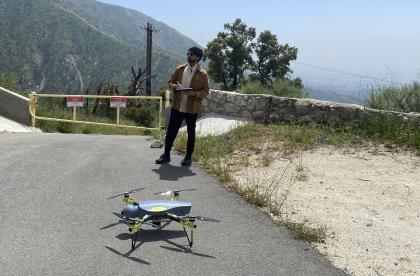Dhanuj Gandikota

Engineer Combines Passions for Ecology and AI to Fight Climate Change
Dhanuj Gandikota
When Dhanuj Gandikota demonstrated Pavlov’s law with home aquarium fish for his third-grade science project, he knew he had a passion for the natural world. What he didn’t know? That he’d someday marry that with an interest in artificial intelligence—to help battle climate change. But that’s exactly what he’s doing at MITRE.
“I’ve always enjoyed researching and mapping complex systems to understand what makes them thrive,” he says. “That's where ecology and data science come together, like modeling large populations into dynamics and patterns.
“For me, AI offers a perfect tool for many climate change solutions.”
Gandikota, who leads environmental AI/machine learning for our climate office, has several irons in the fire in the climate AI space. One literally: collaborating with personnel from Angeles National Forest on using AI for wildfire mitigation.
The initiative evolved out of his proposal under MITRE’S Early Career Research Program and then through our independent R&D program. The effort provided him the chance to spend time with the wildfire professionals and decision-makers on the ground—and hear firsthand of their frustrations and challenges.
The problem is one of many related to climate change that MITRE is driving a whole-of-nation approach to solve. Given that wildfires burned over 7.5 million acres of U.S. land in 2022, the issue couldn’t be more critical. And it’s one Gandikota cares deeply about.
Growing up in Ann Arbor, Mich., he spent abundant time in natural environments. Matthaei Botanical Gardens bordered his backyard, and the nearby Sleeping Bear Dunes National Lakeshore and Tahquamenon Falls State Park offered myriad learning opportunities. He eventually explored landscapes across the state’s Lower and Upper Peninsulas, as well as all five Great Lakes.
By the time college rolled around, he discovered another interest: statistics and machine learning. That inspired him to choose data science as a major, with a focus in AI. But his early love of nature kept coming back. Eventually he added a second major in ecology evolutionary biology—and then a third in computer science.
At the end of each day, I leave feeling fulfilled. Every minute of my time goes toward addressing the devastating effects of climate change.
While at the University of Michigan, he founded and led the Michigan EcoData organization to unify student projects in AI and the environment, an initiative that thrives to this day. His studies helped him appreciate the strong interplay between AI and climate sciences. So he geared his post-graduation job search toward combining the two fields.
“Most opportunities I encountered would’ve put me exclusively in AI, with a possibility to maybe someday work in climate. But MITRE offered a chance to do both,” he says.
“Here, I’m able to propose and work on interesting projects, backed by our role as a trusted adviser, our mission for the public good, and our commitment to help shape the climate innovation space. That’s a winning combination.”
Using AI to Boost Climate Science Solutions

Gandikota prepares for drone data collection at test site in Angeles National Forest.
Gandikota and a MITRE research team are developing a solution to integrate deep learning and generative AI with forestry remote sensing. The goal? To provide a rapid, cost-effective tactical mapping solution for responsive wildfire mitigation—and close the gap between the growing need for disaster relief and personnel limitations in working the problem.
“Understanding all the data out there is far more than the human brain can process,” Gandikota explains. “But AI can take complex things like 3D climate geospatial data across huge areas and distill it down to identify key patterns. This can help climate professionals make informed decisions and create actionable and responsive change.”
Beyond wildfire mitigation, Gandikota also supports a Federal Emergency Management Agency study of climate adaptation to the effects of extreme weather events. He says such experiences provide ample professional growth opportunities—and feed a love of learning embedded since childhood.
He’s also committed to sharing that learned knowledge. He collaborates extensively with external stakeholders as well as colleagues internally, across disciplines, to explore creative ways to tackle the problem. Additionally, he and a few teammates formed a MITRE climate AI discussion group to help exchange ideas and insights.
With just under two years at the company, Gandikota finds working in a dynamic, high-risk area like climate AI highly rewarding.
“I’ve enjoyed unique opportunities even at this early point in my career—leading projects, helping shape corporate vision and strategies, and being valued as a collaborator,” he says. “At the end of each day, I always leave feeling fulfilled. I know every minute of my time goes toward the goal of addressing the devastating effects of climate change on the planet.”
Join our community of innovators, learners, knowledge-sharers, and risk takers. View our Job Openings.